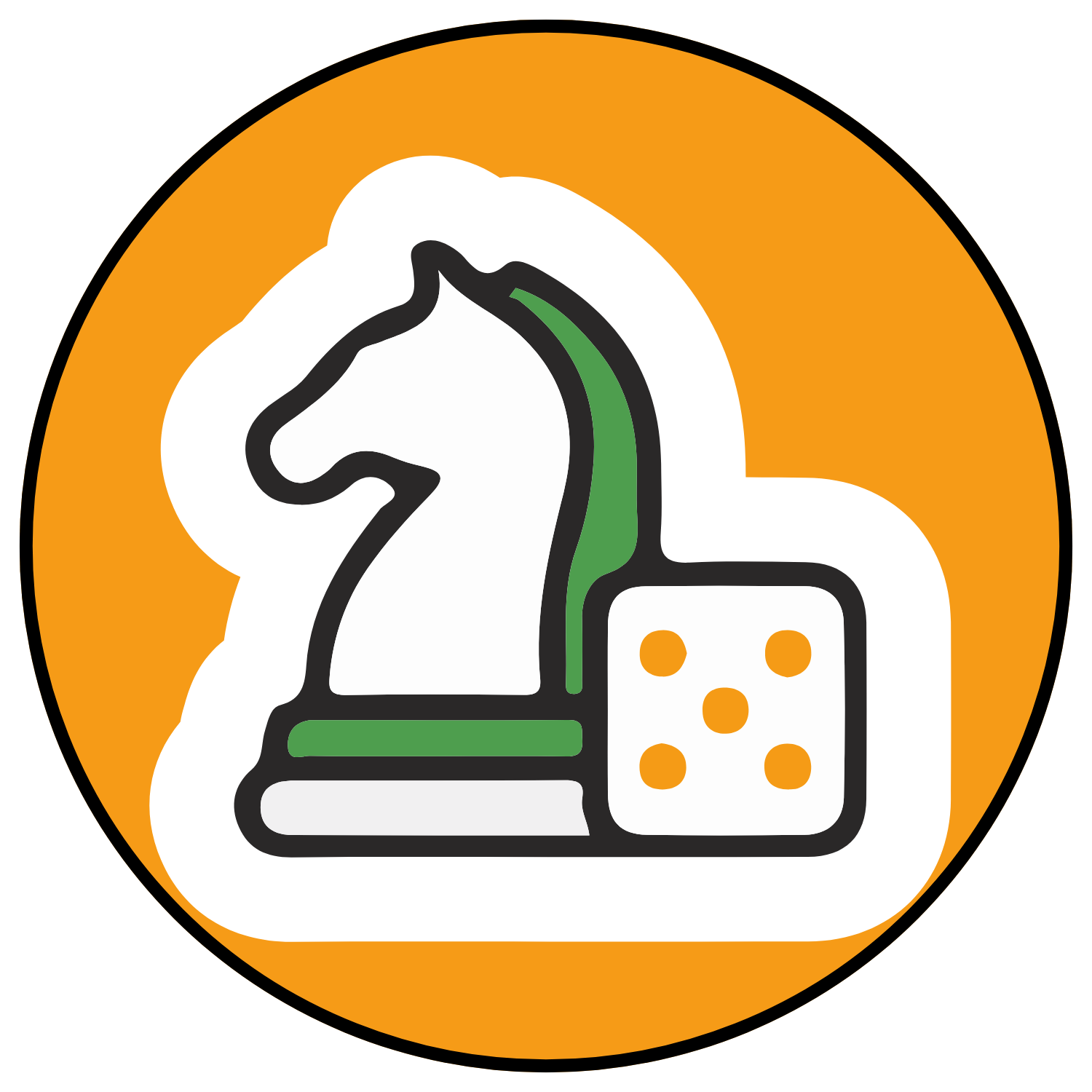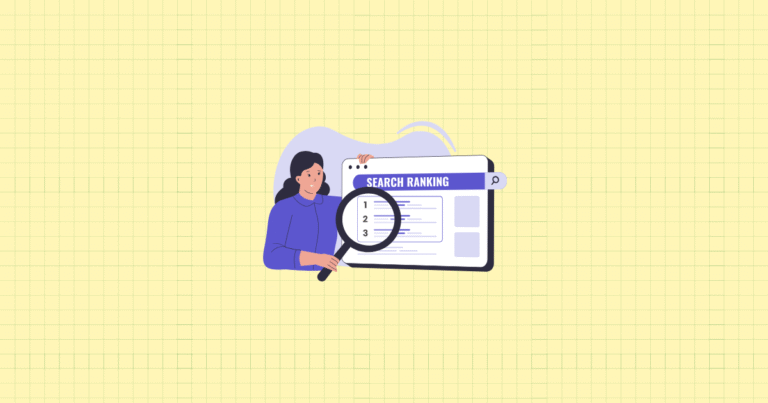In the crowded world of e-commerce, standing out isn’t just desirable—it’s essential for survival. With over 2.5 million active Shopify merchants globally, your store is competing for attention in an increasingly noisy marketplace. But here’s the good news: most of your competitors are leaving valuable opportunities on the table, especially when it comes to content.
Ever wondered how some Shopify stores seem to effortlessly attract traffic, engage customers, and drive sales while others struggle to gain traction? The difference often lies in their approach to content—and more specifically, how strategically they analyze and outmaneuver their competition.
Competitive content analysis isn’t about copying what others do. It’s about understanding the landscape, identifying gaps, and crafting a content strategy that positions your store as the obvious choice for customers. By the end of this guide, you’ll have a systematic approach to dissect competitor content strategies, uncover hidden opportunities, and develop content that genuinely outperforms the competition.
The Competitive Landscape of E-commerce
The Shopify ecosystem has transformed e-commerce by dramatically lowering the barriers to entry. What once required significant technical expertise and capital investment can now be accomplished with a few clicks and a modest budget. This accessibility is a double-edged sword—it’s never been easier to launch an online store, but standing out has never been more challenging.
In saturated markets, products alone rarely provide sustainable differentiation. Your competitors can source similar items, match your prices, or even copy your store design. But content? That’s where true differentiation happens. Content shapes how customers perceive your brand, influences their purchase decisions, and builds relationships that transcend individual transactions.
The stats tell a compelling story: Shopify stores with quality blogs generate 67% more leads than those without. Meanwhile, detailed product content can increase conversion rates by up to 36%. In today’s competitive landscape, content isn’t just nice to have—it’s a critical driver of visibility, acquisition, and conversion.
Benefits of Conducting Competitive Content Analysis
Diving into competitive content analysis delivers three game-changing benefits for your Shopify store. First, it reveals market opportunities hiding in plain sight. That competitor ranking for valuable keywords? The product descriptions that convert at twice the industry average? The blog posts driving significant social engagement? These are all breadcrumbs leading to untapped potential for your store.
Second, it transforms your decision-making from guesswork to strategy. Instead of creating content based on hunches or copying surface-level trends, you’ll have data-driven insights to guide your investments. You’ll know which content types deliver the best ROI, which topics resonate with your audience, and which approaches are most likely to drive results.
Finally, competitive analysis accelerates your growth trajectory by helping you learn from others’ successes and failures. Why reinvent the wheel when you can study what works, adapt it to your unique context, and improve upon it? This isn’t about plagiarism—it’s about standing on the shoulders of others to reach new heights.
A store owner I worked with spent months creating infographics that barely moved the needle, only to discover through competitive analysis that his audience overwhelmingly preferred video demonstrations. Within weeks of pivoting his strategy, his engagement metrics doubled and conversion rates jumped 17%. That’s the power of competitive insight.
Identifying and Categorizing Your True Shopify Competitors
Before diving into content analysis, you need clarity on exactly who your competitors are. This might seem obvious, but many Shopify store owners make the mistake of focusing on the wrong competitors—either fixating on industry giants they can’t realistically compete with or overlooking emerging threats flying under the radar.
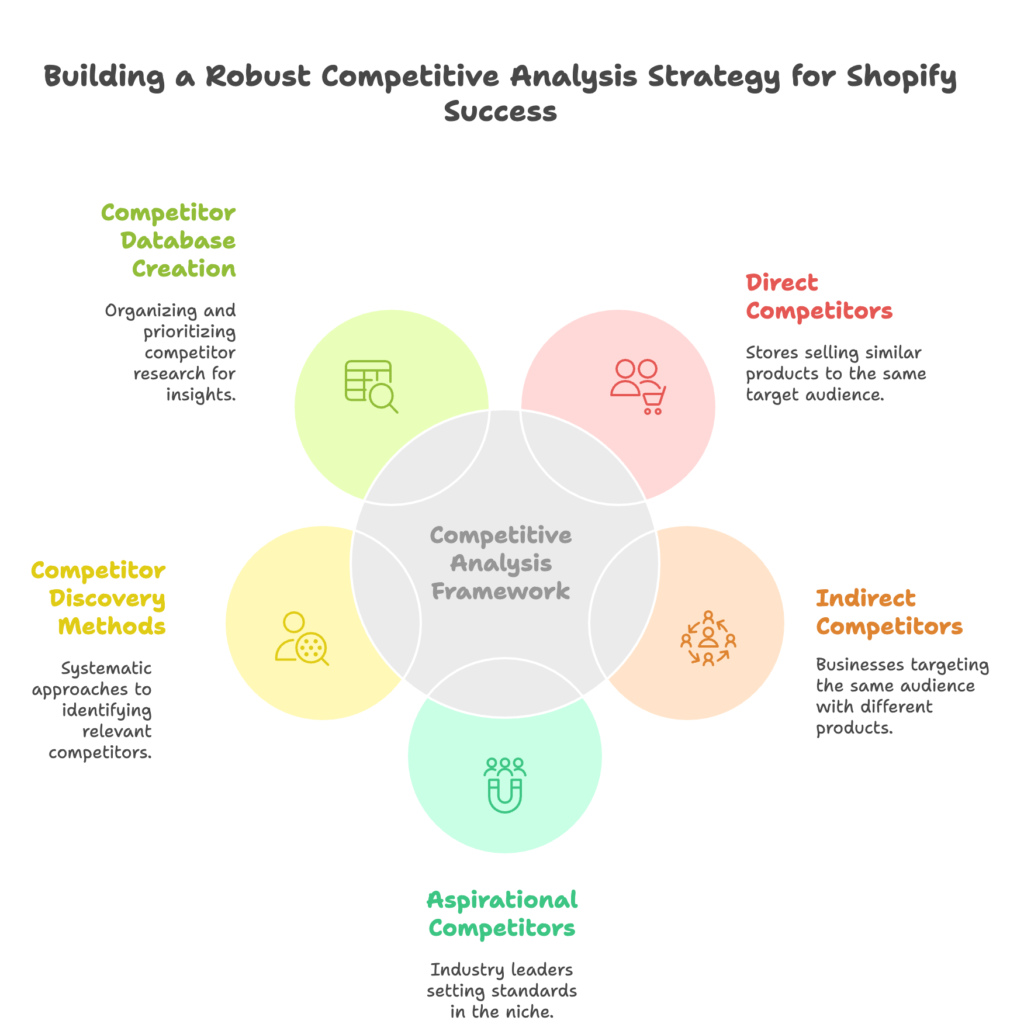
Defining Your Competitive Landscape
Your competitive landscape has three distinct layers, each offering different insights for your content strategy.
Direct competitors are the stores selling similar products to the same target audience at comparable price points. These are your primary competition—the stores customers are likely comparing you against before making a purchase decision. For a sustainable footwear brand, direct competitors might include other eco-friendly shoe companies targeting environmentally conscious consumers in the same price range.
Don’t limit yourself to stores of similar size. A smaller competitor with a dedicated following can offer valuable insights, while a larger one can reveal scalable strategies worth adapting.
Indirect competitors target the same audience but with different products or solutions. They compete for your customers’ attention and budget, even if they don’t sell identical items. For our sustainable footwear store, indirect competitors might include ethical clothing brands or even subscription services for eco-friendly products.
These competitors are particularly valuable for understanding broader content themes that resonate with your audience, regardless of specific product features.
Aspirational competitors are the industry leaders setting the standard in your niche. They might be significantly larger or more established than your store, making direct competition unrealistic in the short term. However, they provide a valuable north star for your content strategy.
Studying how Allbirds or Veja communicate sustainability, for instance, can inspire elevated approaches for our footwear example—even if matching their content budget isn’t currently feasible.
Methods for Discovering Relevant Competitors
Finding the right competitors requires more than a quick Google search. Here are three systematic approaches to building a comprehensive competitor list:
Keyword-based competitor research identifies stores competing for the same search visibility. Tools like Ahrefs, SEMrush, or even the free Ubersuggest can reveal which stores rank for your target keywords.
Start by listing 10-15 keywords most relevant to your products. For our sustainable footwear example, these might include “eco-friendly sneakers,” “sustainable running shoes,” or “ethical footwear.” Search for these terms and note which stores consistently appear in the results.
Don’t forget to analyze paid search competitors too—stores investing in PPC advertising for your keywords are actively competing for the same customer attention.
Audience-based research focuses on where your target customers spend their time and money. This approach often uncovers competitors you might otherwise miss.
Consider sending a brief survey to your customers asking which other stores they considered before purchasing from you. Social listening tools like Mention or Brand24 can identify brands frequently mentioned alongside yours in online conversations.
SparkToro is particularly powerful for this approach—enter your audience descriptor (e.g., “people interested in sustainable footwear”), and it will reveal which websites, social accounts, and content they frequently engage with.
Shopify-specific research methods leverage tools designed specifically for the platform. Koala Inspector lets you identify whether a store uses Shopify and provides insights into their theme, apps, and product information. Shop Score helps benchmark performance against similar stores in the Shopify ecosystem.
The Shopify Exchange marketplace, where stores are bought and sold, can also provide insights into comparable businesses in your niche.
Creating a Structured Competitor Database
With a comprehensive list of potential competitors, it’s time to prioritize and organize your research. Trying to analyze too many competitors leads to overwhelm and surface-level insights rather than actionable intelligence.
Select 5-10 key competitors for in-depth analysis, balancing different types:
- 3-5 direct competitors (your primary focus)
- 2-3 indirect competitors (for broader audience insights)
- 1-2 aspirational competitors (for inspiration and benchmarking)
Include both established players and emerging threats to ensure you’re not blindsided by newcomers disrupting the space.
Create a competitive analysis spreadsheet with tabs for different analysis areas. The main tab should include key information about each competitor:
- Company name and URL
- Competitor type (direct, indirect, aspirational)
- Target audience and positioning
- Product overlap (high, medium, low)
- Price positioning relative to yours
- Estimated traffic (from tools like SimilarWeb)
- Content channels they utilize
- Notable strengths and weaknesses
This database becomes your command center for competitive intelligence, allowing you to track changes over time and identify emerging patterns. Plan to revisit and update this information quarterly to keep your insights fresh.
Analyzing Competitors’ Content Strategies and Performance
Now comes the detective work. With your competitor list in hand, it’s time to dig into the specifics of their content strategies. This isn’t about casual browsing—it’s a systematic analysis of what they’re creating, how well it’s performing, and how they’re distributing it to their audience.
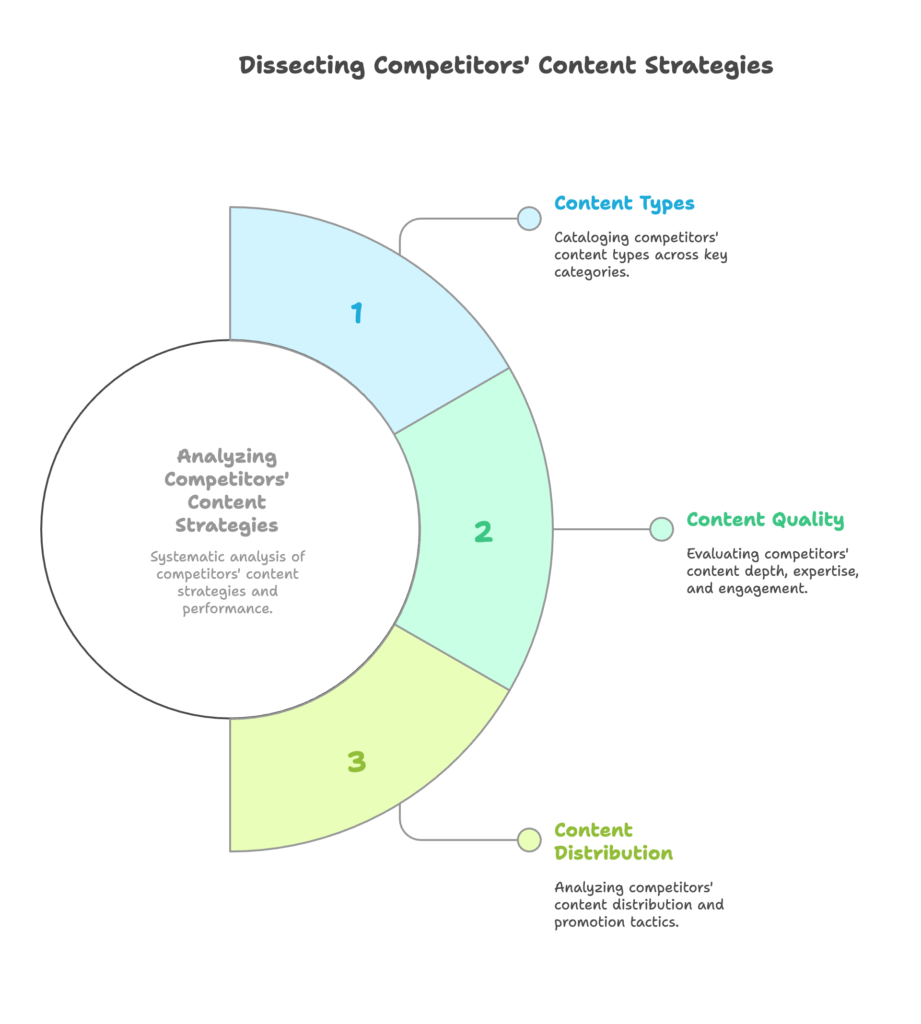
Evaluating Content Types and Formats
Begin by cataloging the content types your competitors leverage across three key categories:
Product content directly supports the shopping experience. Analyze how competitors structure their product descriptions—do they lead with features or benefits? How technical are their specifications? Do they include sizing guides, material information, or sustainability credentials?
Pay particular attention to visual content strategies. Are they using lifestyle photography, detailed close-ups, or 360-degree views? Do they incorporate videos showcasing the product in use? How about user-generated content or social proof? Note both the types of visual content and their quality.
One sporting goods Shopify store I consulted for discovered their main competitor was using short, looping videos for each product variation—a simple addition that was dramatically reducing their return rate by setting clear expectations.
Marketing content attracts and engages potential customers. Analyze competitors’ blogs for content themes, frequency, and depth. Are they publishing in-depth guides or quick tips? How often do they post, and do they focus on seasonal trends or evergreen topics?
Examine their email marketing by subscribing to their newsletters and abandoned cart sequences. Note their subject line strategies, email frequency, and how they balance promotional content with value-add information.
Social media requires channel-specific analysis. For each platform competitors use, document:
- Posting frequency and timing
- Content types that generate the most engagement
- Voice and tone differences across platforms
- Use of platform-specific features (e.g., Instagram Stories, TikTok challenges)
- Balance between promotional and relationship-building content
Educational and support content addresses customer questions and builds trust. Evaluate the comprehensiveness of competitors’ FAQs and knowledge bases. Do they cover pre-purchase questions, technical support, and policy information? How accessible is this information?
Look for tutorial content, how-to guides, and customer onboarding materials. These often reveal how competitors are addressing pain points and objections throughout the customer journey.
Assessing Content Quality and Effectiveness
Beyond cataloging what exists, you need to evaluate how well it’s working. This requires both qualitative assessment and quantitative metrics.
Content depth and comprehensiveness can be evaluated by comparing word counts, detail levels, and topic coverage. Are competitors creating quick, surface-level content, or comprehensive resources that answer every potential question?
Look for signals of expertise, authority, and trustworthiness (E-A-T). Do they cite sources, include expert opinions, or share original research? Do they address common customer concerns proactively?
Content engagement metrics provide objective feedback on performance. Use tools like BuzzSumo to see social shares for competitors’ content. For blog posts, browser extensions like SimilarWeb can estimate time on page and bounce rates.
Pay attention to the volume and sentiment of user-generated content. Are customers actively engaging with the brand through reviews, comments, and social mentions? What themes emerge in this feedback?
Content conversion performance can be harder to measure directly, but there are indicators to watch for. Examine call-to-action placement, language, and design across competitor content. Do they use different CTAs for different funnel stages?
Map content-driven conversion paths by starting at a blog post and following the intended user journey to purchase. How many steps are required? What incentives are offered along the way?
While you can’t access competitors’ internal analytics, you can estimate content attribution by noting which content they prominently feature, promote, or repurpose—these are likely their highest-performing assets.
Analyzing Content Distribution and Promotion
Even the best content fails without effective distribution. Understand how competitors are getting their content in front of your shared audience.
SEO strategy assessment reveals how competitors drive organic traffic. Use tools like Ahrefs or SEMrush to identify which keywords they’re targeting and ranking for. Analyze their on-page optimization techniques, including title tag structures, meta descriptions, and heading hierarchies.
Examine their content structure and internal linking patterns. Do they use pillar pages and cluster content? How do they connect related information across their site? These patterns reveal their SEO priorities and content architecture strategy.
Social media distribution tactics go beyond what they post to how they amplify it. Which platforms receive the most attention? How do they adapt content for each channel rather than simply cross-posting?
Document posting frequency, timing patterns, and engagement strategies. Do they actively respond to comments? Participate in relevant groups or communities? Use platform-specific features to increase reach?
Paid content promotion analysis shows where competitors are investing their marketing budget. Use Facebook’s Ad Library to see their social media advertisements. Pay attention to which content they choose to amplify with paid spending—this often indicates their highest-converting assets.
Look for evidence of Google Ads campaigns driving traffic to content rather than product pages, suggesting they’re using content for lead generation. Also note any content syndication or partnerships that extend their reach beyond owned channels.
Identifying Content Gaps and Competitive Advantages
Now comes the exciting part—turning your analysis into actionable opportunities. This is where you move from understanding what exists to identifying what’s possible.
Conducting Content Gap Analysis
Content gaps are the spaces between what customers want to know and what’s currently available. They represent prime real estate for your content strategy.
Keyword-based content gaps are topics with search demand that competitors aren’t adequately addressing. Ahrefs’ Content Gap feature specifically identifies keywords your competitors rank for that you don’t.
Prioritize these opportunities based on search volume, keyword difficulty, and commercial intent. Focus first on high-volume, lower-difficulty keywords with clear purchase intent.
A home furnishings store I worked with discovered through this analysis that while competitors were targeting broad terms like “modern coffee tables,” none were creating content for high-intent modifiers like “round marble coffee table 36 inch”—specific terms used by buyers who know exactly what they want.
Topic and theme gaps may not always have obvious keyword volume but represent valuable content opportunities. Look for subjects competitors aren’t covering adequately, emerging trends they’ve missed, or customer questions left unanswered.
Review competitors’ product reviews, comments, and social media to identify recurring questions or frustrations. Each of these represents a content gap you can fill.
Format and medium gaps exist when competitors are creating content in limited formats. Are they focused entirely on written content while ignoring video? Are they missing opportunities for interactive tools, calculators, or configurators?
Mobile-specific content gaps are particularly valuable, as many Shopify stores still deliver suboptimal mobile experiences despite most traffic coming from smartphones.
Evaluating Competitor Content Weaknesses
Beyond identifying what’s missing, look for areas where existing competitor content falls short.
Quality and accuracy issues create opportunities to position your content as more reliable. Look for outdated information, factual errors, or superficial coverage of important topics.
Competitors often rush to publish without thorough research or expert input. By creating more accurate, up-to-date, and comprehensive resources on the same topics, you can quickly establish authority.
User experience problems are common content weaknesses. Evaluate how competitors organize their content. Is it difficult to navigate? Buried in unintuitive categories? Does it load slowly or display poorly on mobile devices?
Creating a superior content experience—even with similar information—can be a significant competitive advantage. One beauty brand I consulted for saw a 28% increase in content engagement simply by reorganizing their ingredient guides into a more user-friendly format than their competitors.
Engagement and conversion shortcomings often stem from weak calls-to-action, lack of persuasive elements, or disconnection between content and products. Note where competitors’ content fails to bridge the gap between information and purchase.
Are they creating helpful buying guides but not connecting them to relevant products? Sharing valuable how-to content without clear next steps for the reader? These conversion gaps represent immediate opportunities.
Discovering Your Unique Content Opportunities
The most powerful content strategy leverages what makes your store uniquely valuable to customers.
Leveraging your brand’s unique strengths means identifying proprietary knowledge, experiences, or perspectives that competitors can’t easily replicate.
Do you have specialized expertise in your product category? A compelling founder story that humanizes your brand? Access to exclusive data or insights? These assets can form the foundation of truly differentiated content.
A sustainable clothing store I worked with discovered their greatest content advantage was the founder’s 15 years in textile manufacturing—knowledge that allowed them to create authoritative content about fabric sourcing that resellers simply couldn’t match.
Identifying underserved customer segments reveals audience opportunities your competitors are missing. Are there niche use cases for your products that aren’t being addressed? Geographic or demographic segments receiving generic content that doesn’t speak to their specific needs?
Creating targeted content for these overlooked segments can quickly establish your store as the go-to resource for these customers.
Creating differentiated content approaches means developing a distinctive voice, format, or perspective that stands out in your market.
Can you bring a fresh viewpoint to tired topics? Adopt a more conversational tone in an industry dominated by technical jargon? Combine information and entertainment in a way competitors aren’t?
Sometimes the opportunity isn’t new information but a new way of presenting it that resonates more deeply with your audience.
Developing a Superior Content Strategy Based on Competitive Insights
With a clear understanding of the competitive landscape and your unique opportunities, it’s time to develop a cohesive content strategy that outperforms your competitors.
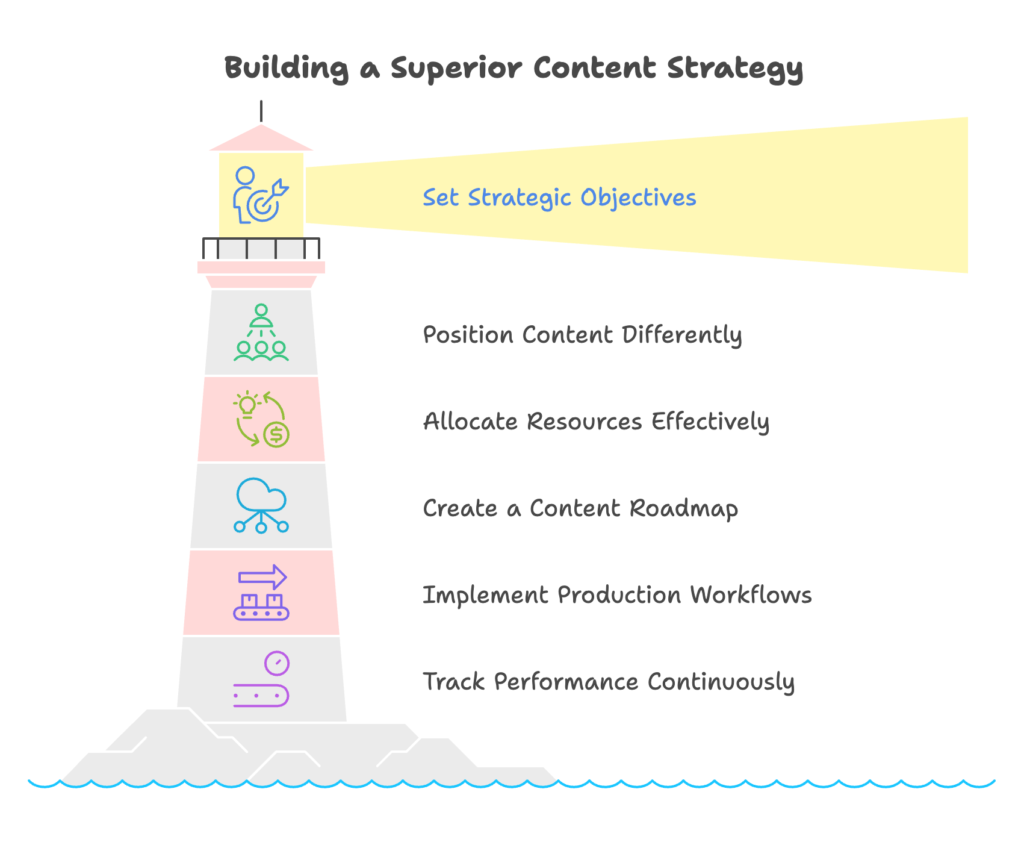
Setting Strategic Content Objectives
Content without clear objectives is just noise. Define what success looks like before creating a single piece of content.
Defining content goals and KPIs ensures you’re measuring what matters. Set specific, measurable targets for:
- Traffic and visibility metrics (organic traffic, search rankings, social reach)
- Engagement indicators (time on page, scroll depth, social interactions)
- Conversion metrics (email sign-ups, add-to-carts, purchases)
- Customer retention and loyalty measures (repeat visits, account creation)
These goals should align with your broader business objectives. A new store might prioritize awareness and visibility, while an established one might focus on conversion optimization or customer loyalty.
Establishing competitive positioning means defining how your content will stand out. Based on your competitive analysis, determine:
- Your content differentiation strategy (more comprehensive, more specialized, better designed, etc.)
- Core messaging and value propositions that separate you from competitors
- Brand voice and personality development that reflects your unique positioning
Document these decisions in a content positioning statement that guides all future creation: “Our content will be the most [differentiator] resource for [audience] looking to [goal], unlike [competitors] who [limitation].”
Resource allocation planning ensures you can execute your strategy effectively. Based on competitor benchmarking, determine:
- Content creation budget and resources needed to compete effectively
- Technology and tool investments required for production and distribution
- Team structure and responsibilities, whether in-house or outsourced
Be realistic about what you can sustain. Consistent, high-quality content in fewer channels outperforms sporadic efforts across many platforms.
Creating a Content Roadmap
With objectives defined, create a structured plan for content development and distribution.
Content topic prioritization should balance opportunity size with resource requirements. Start by targeting:
- High-value keyword opportunities identified in your gap analysis
- Critical content addressing questions at key decision points in the customer journey
- Topics that directly capitalize on competitor weaknesses
A beauty brand I advised created a simple scoring system for topic prioritization: (Search Volume × Conversion Potential) ÷ (Keyword Difficulty × Production Complexity). This formula helped them focus first on high-return, lower-effort content opportunities.
Content calendar development transforms your priorities into an actionable publishing schedule. Determine:
- Publishing frequency based on your resources and competitive benchmarks
- Seasonal and promotional content aligned with your business calendar
- Content refresh and update schedule for existing assets
Balance creating new content with updating high-performing existing pieces. Often, refreshing a successful article yields better returns than creating something entirely new.
Content format and channel strategy ensures you’re creating the right content types for your audience and goals. Document:
- Primary content formats based on audience preferences and competitive gaps
- Distribution channels prioritized by audience presence and engagement
- Cross-platform adaptation approach for efficient content repurposing
Don’t automatically adopt every format competitors use. Focus on the intersection of what your audience values and what you can consistently execute with excellence.
Implementing Content Production Workflows
Even the best strategy fails without effective execution. Establish systematic processes to ensure consistent quality and efficiency.
Content creation process documentation should include:
- Research protocols for gathering accurate information and competitive insights
- Writing and production standards that reflect your brand guidelines
- Quality control and approval procedures to maintain consistency
Create templates for common content types to accelerate production while ensuring brand consistency. Develop a resource library of approved statistics, product information, and brand messaging to streamline creation.
SEO implementation should be integrated throughout your content process, not added as an afterthought. Develop:
- Keyword integration guidelines that balance search optimization with readability
- On-page optimization checklists for creators and editors
- Technical SEO considerations specific to Shopify’s architecture
Shopify-specific considerations include URL structure limitations, theme-based schema implementation, and collection page optimization.
Content performance tracking closes the loop between strategy and results. Establish:
- Analytics setup and dashboard creation for monitoring key metrics
- Regular reporting schedule for reviewing performance
- Continuous improvement methodology to apply learnings
Create a simple scoring system that evaluates each piece of content against your defined KPIs, allowing you to quickly identify what’s working and what needs adjustment.
Implementing Advanced Content Tactics to Outperform Competitors
With your strategy and processes in place, let’s explore advanced tactics that can give your content a competitive edge in the Shopify ecosystem.
Creating Superior Product Content
Product content directly impacts conversion rates and is often the area where small improvements yield the biggest results.
Enhanced product descriptions should go beyond technical specifications to create desire and overcome objections. Implement:
- Benefit-focused copywriting that connects features to customer outcomes
- Storytelling elements that create emotional connection with the product
- SEO optimization that incorporates natural keyword usage without sacrificing readability
For example, rather than simply listing “200g recycled polyester fabric,” explain how “the lightweight, 200g recycled polyester fabric keeps you comfortable during intense workouts while diverting plastic bottles from landfills—each jacket repurposes approximately 25 bottles.”
Advanced visual content strategies significantly impact purchase confidence. Develop standards for:
- High-quality product photography showing multiple angles and contexts
- Video demonstrations highlighting key features and use cases
- User-generated content showcasing real customers using your products
A furniture Shopify store I consulted with increased conversion rates by 24% by simply adding contextual lifestyle photos showing products in different room styles, helping customers visualize the pieces in their own homes.
Interactive product experiences create engagement beyond static content. Consider implementing:
- 360-degree product views that allow customers to examine items from all angles
- Augmented reality try-on features for apparel or home goods
- Product customization visualizers that show real-time changes
These features not only improve conversion rates but also reduce return rates by setting accurate expectations. Several Shopify apps now make these interactive elements accessible even to smaller stores.
Developing High-Value Marketing Content
Marketing content builds awareness, nurtures prospects, and differentiates your brand. Focus on creating assets with long-term value.
In-depth educational resources establish your authority and attract quality traffic. Develop:
- Comprehensive buying guides that help customers make informed decisions
- Industry trend reports showcasing your market expertise
- Expert interviews and thought leadership content that competitors can’t easily replicate
These cornerstone content pieces often become link magnets, driving both referral traffic and improving domain authority.
Community-building content fosters relationships beyond transactions. Consider:
- Customer stories and case studies highlighting creative product uses
- Interactive Q&A forums where you actively address customer questions
- Virtual events and webinars that provide value while showcasing your products
A sustainable home goods store I worked with hosts monthly “Sustainable Living” webinars featuring their products in context, building a community of over 15,000 engaged followers who have become brand advocates.
Conversion-focused content bridges the gap between information and purchase. Create:
- Comparison content that objectively evaluates your products against alternatives
- ROI calculators and decision tools that quantify the value of your offerings
- Testimonial collections strategically organized by customer pain points
Be honest in comparison content—acknowledging where competitors excel while highlighting your unique advantages builds credibility and attracts the right customers for your products.
Optimizing Content for Shopify’s Ecosystem
Shopify’s platform has specific features and limitations that smart merchants leverage to maximize content effectiveness.
Shopify blog optimization involves working within and around platform constraints:
- Theme customization to improve readability and engagement
- Strategic integration of related products within blog content
- Email capture optimization to convert content readers into subscribers
While Shopify’s native blog functionality is basic compared to dedicated platforms like WordPress, strategic customization can create a highly effective content hub. Consider custom theme modifications or specialized content apps if the default blog limitations are holding back your strategy.
Leveraging Shopify apps for content enhancement extends your capabilities without custom development. Evaluate:
- Product review and user-generated content applications
- Quiz and recommendation tools that create interactive experiences
- Content personalization solutions that adapt based on visitor behavior
The key is selecting apps that integrate seamlessly with your theme and content strategy rather than creating disconnected experiences.
Integrating content across the customer journey ensures consistent messaging at every touchpoint:
- Pre-purchase education and nurturing content in email flows and ads
- Post-purchase onboarding and support materials to enhance satisfaction
- Retention and loyalty content programs that drive repeat purchases
Map your content to customer journey stages, identifying gaps where prospects might lose momentum or existing customers might disengage.
Measuring Success and Continuously Evolving Your Content Strategy
Content marketing isn’t a “set it and forget it” activity. Sustainable competitive advantage comes from continuous measurement, learning, and adaptation.
Tracking Content Performance Against Competitors
Regular competitive benchmarking keeps your strategy aligned with market realities and emerging opportunities.
Competitive benchmarking metrics should include:
- Organic search visibility comparison for target keywords
- Social engagement and share of voice relative to competitors
- Content-driven conversion rate comparison where possible
Track these metrics over time, looking for trends rather than point-in-time comparisons. A declining share of voice for specific topics may indicate a competitor’s renewed focus in that area.
Tools for ongoing competitive monitoring automate much of this intelligence gathering:
- SEO tools like Ahrefs or SEMrush for ranking and visibility tracking
- Social listening platforms like Mention or BrandWatch for engagement monitoring
- Web analytics tools with benchmarking features for performance comparison
Set up automated alerts for significant competitor changes, such as new content categories, structural website changes, or dramatic ranking movements.
Creating competitive performance dashboards centralizes this intelligence for easier analysis:
- Visualize key metrics side-by-side with competitor benchmarks
- Identify trends that might indicate shifts in competitive strategies
- Share insights across teams to inform broader business decisions
These dashboards should be living documents, reviewed regularly and updated as competitive dynamics evolve.
Iterative Content Optimization
Continuous improvement yields better results than periodic overhauls. Establish regular processes for refinement.
Content audit and refresh processes should be scheduled quarterly:
- Conduct content inventory assessments to identify all existing assets
- Flag underperforming content for improvement or archiving
- Implement content update protocols for factual accuracy and freshness
Often, updating and expanding existing content yields better returns than creating entirely new pieces. Focus particularly on high-potential content that’s underperforming—posts ranking on page two of search results or with high traffic but low conversion rates.
A/B testing and experimentation reveal what resonates with your specific audience:
- Test headlines and opening paragraphs to improve engagement
- Experiment with content formats and structures for better comprehension
- Try different calls-to-action and conversion paths to optimize results
Develop a formal testing calendar that prioritizes high-traffic content where small improvements can deliver significant results.
Customer feedback integration keeps your content aligned with audience needs:
- Implement content satisfaction surveys on key pages
- Conduct periodic user testing sessions to observe how visitors interact with your content
- Analyze comments and engagement for insights into audience preferences
This qualitative feedback often reveals opportunities that metrics alone might miss—like confusing explanations, missing information, or emerging questions not addressed in your content.
Staying Ahead of Competitive Content Trends
Maintaining your competitive edge requires anticipating shifts in content trends and technologies before they become mainstream.
Emerging content format adoption should be evaluated through the lens of audience value, not novelty:
- Monitor new media types and technologies gaining traction in your industry
- Assess platform-specific content innovations for potential adaptation
- Experiment with interactive and immersive experiences where they add genuine value
Be selective—adopting every new format creates unsustainable workload. Prioritize those with clear alignment to your audience needs and business goals.
Content distribution evolution often drives results more than content creation innovations:
- Identify new channel opportunities where your audience is gathering
- Monitor algorithm changes on existing platforms and adapt accordingly
- Stay attuned to shifting audience discovery behaviors
For instance, the growing preference for video search on platforms like TikTok and YouTube represents a significant shift in how younger audiences discover products—one that content strategies must address.
Long-term content strategy development focuses on building sustainable advantages:
- Develop a content ecosystem with interconnected assets supporting each other
- Systematically build domain authority in specific topical areas
- Create proprietary content assets that competitors cannot easily replicate
The most durable content advantages come from consistency, depth, and unique perspective—attributes that require time to develop but deliver compounding returns.
Conclusion: Building a Sustainable Competitive Advantage Through Content
Throughout this guide, we’ve explored how strategic competitive content analysis can transform your Shopify store’s performance. Let’s recap the key insights and outline your path forward.
Key Takeaways for Shopify Store Owners
The critical role of competitive analysis cannot be overstated. Regular monitoring of competitor content strategies provides a roadmap of opportunities and pitfalls. Make competitive intelligence gathering a standard business practice, not a one-time exercise.
Data-driven decision making separates strategic content from aimless publishing. Use the metrics and insights from your analysis to guide investments, measure results, and demonstrate ROI.
Balance competitive response with innovation. While it’s important to address gaps where competitors are outperforming you, true differentiation comes from charting your own course based on unique brand strengths.
Content as a strategic asset grows in value over time. Unlike paid advertising that stops delivering when you stop paying, quality content creates compound returns through improved search rankings, increased referrals, and enhanced brand authority.
Content’s role in differentiation becomes increasingly important as product and price advantages become harder to maintain. In crowded markets, how you communicate your value can be as important as the value itself.
Building proprietary content advantages—through unique data, specialized expertise, or distinctive creative approaches—creates barriers that competitors cannot easily overcome.
Next Steps and Action Plan
To implement the strategies outlined in this guide, focus on these prioritized actions:
Immediate actions (next 30 days):
- Conduct your initial competitor analysis, identifying 5-10 key competitors
- Identify the top 3-5 content opportunities based on competitor gaps and your unique strengths
- Set up basic tracking and measurement to establish baseline metrics
Medium-term strategy development (1-3 months):
- Create a comprehensive content roadmap based on competitive insights
- Develop or strengthen your content creation capabilities, whether in-house or outsourced
- Implement testing and optimization processes for continuous improvement
Long-term competitive positioning (3-12 months):
- Develop unique content assets that showcase your specific expertise or perspective
- Build direct audience relationships through owned channels like email lists and communities
- Create barriers to competitive imitation through proprietary approaches or data
Remember that content marketing is a marathon, not a sprint. The most successful Shopify stores consistently execute their content strategy over time, learning and adapting as they go.
By systematically analyzing your competition, identifying strategic opportunities, and executing with excellence, you can build a content advantage that drives sustainable growth for your Shopify store. The marketplace rewards those who don’t just create content, but create strategic content informed by competitive intelligence and aligned with customer needs.
References
- Fabrikator. (2025, January 22). Best Competitor Analysis for Shopify Stores. https://www.fabrikator.io/blog/competitor-analysis-for-shopify-stores-what-metrics-to-follow-and-what-tools-to-use
- ClearVoice. (n.d.). How to Use Competitive Analysis to Build a Content Strategy. https://www.clearvoice.com/resources/competitive-content-analysis/
- Open Store. (2025, February 18). How a Shopify Competitor Analysis Can Unlock Massive Growth. https://open.store/blog/shopify-competitor-analysis
Ready to supercharge your Shopify store’s sales with perfectly optimized discount codes and campaigns? Growth Suite is a Shopify app that helps you analyze customer behavior, create personalized offers, and boost your conversion rates with smart, time-limited promotions. The app’s AI-driven engine makes real-time offers based on visitor intent, protecting your brand while increasing sales. Install Growth Suite with a single click and start seeing results with your 14-day free trial!
Don’t forget to check other articles;
